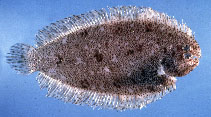| Diagnosis: |
Dorsal soft rays (total): 64-71; Anal soft rays: 50-52; Vertebrae: 35-36. Diagnosis. Dorsal rays 64-71; anal rays 50-52; dorsal and anal rays unbranched; pelvic rays 5; caudal rays 18, 14 branched. Lateral-line scales 68-73 (counted to origin of dorsoanterior branch on head). Only tips of cteni projecting beyond posterior edge of scales, with at most 8 cteni tips posteriorly on body, fewer anteriorly. Eyes separated by 3 rows of scales at narrowest place, with an additional row medially and anteriorly on each eye. Vertebrae 35-36 (usually 35); dorsal pterygiophores anterior to fourth neural spine 10-11. Body depth 2.3-2.55 in SL; head length (HL) 4.4-4.8 in SL; snout length 2.3-2.5 in HL. Scales anteriorly on head replaced by slender cirri, progressively longer, those at ventral edge of head and front of snout up to three-fourths eye diameter in length. Lateral line aligned with dorsal edge of upper eye, ending with a dorsoanterior branch of 7-9 pored scales, straight branch of 4-6 scales, and ventral branch of 7-9 scales; no pores detected beneath scales on ocular side of body. Eye diameter 5.0-6.5 in HL; upper eye overlapping anterior one-half to three-fourths of lower eye; narrowest vertical interorbital space 8.2-9.0 in HL; upper end of gill opening at level of ventral fleshy edge of lower eye: tubular anterior nostril broad, not reaching fleshy base of lower eye when laid back. Caudal peduncle absent, depth at base of caudal fin 1.55-1.8 in HL; caudal fin rounded, its length 4.1-4.5 in SL. Longest dorsal ray 1.35-1.5 in HL; blind side of dorsal and anal rays with a lengthwise thin membranous ridge, broad at base and narrowing as it extends up to three-fourths ray length anteriorly, progressively shorter and narrower posteriorly; edge of membrane on anterior rays of blind side of dorsal fin with cirri; pelvic fins 1.9-2.05 in HL, the tip of longest ray extending to base of second or third anal ray; ocular-side pelvic fin distinctly anterior and larger than fin of blind side; both fins broadly joined by membrane from their fifth rays and jointly to the large genital papilla about one-half length above its base. Color in alcohol light brown, densely dotted with black and short black scale edges; scattered roundish pale spots smaller than eye variously present, some free of black dots; median fins with black dots, but fewer than on body; one specimen with a few large dark blotches on lateral line and on either side of lateral line (Ref. 57560). |

